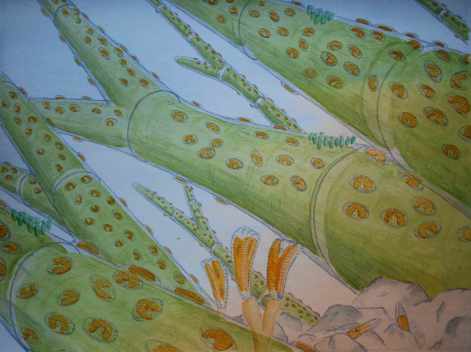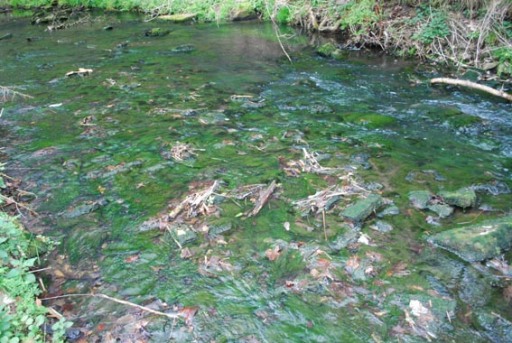A microscopic view of the River Team, near Causey Arch, showing Cladophora glomerata filaments with epiphytic Cocconeis spp (mostly C. euglypta), Rhoicosphenia abbreviata and the cyanobacterium Chamaesiphon incrustans. At the bottom right hand corner there is a patch of sediment inhabitated by Nitzschia palea. This is a composite based on various visits over the past few years. The Rhoicosphenia abbreviata cells in the foreground are approximately 20 micrometres (=1/50th of a millimetre) long.
My intention with my paintings of the submerged world was partly to convey the wonder of the microscopic world to the wider world, but also to provoke a debate with colleagues about what the data that we spent so many hours collecting, actually means. One consequence of this is that I have to go back to some of my earliest pictures and change them, in response to the feedback I receive. This picture is a case in point. To be frank, my original image of the River Team (see “An Indian summer on our riverbanks …”) was one of the earliest that I had produced (back in 2009) and I have learned quite a lot about the media that I use to produce the images in the interim. I had been hunting through my collection of pictures to find one to illustrate a scientific paper that I am writing with colleagues, and ended up producing a completely new image.
These days, the bed of the River Team is usually smothered with lush growths of the green alga Cladophora glomerata although when I first arrived in the region in 1983, you never saw it in the river, as it could not tolerate the high concentrations of zinc released from a battery factory a few kilometres upstream. That factory has long since closed, but the river still receives effluent from a sewage works, and is one of the few rivers in the north east where I still see sewage fungus.
A quick look at my records for this one short but rather polluted river puts the diversity of the microscopic world into perspective. I have records for 59 different samples on my database from 13 sites, spanning a distance of about 15 kilometres collected between 2004 and the present and these contain 175 different species of diatom. Many of these are not very common (more than half never form more than one per cent of the total and about a quarter were only ever recorded in a single sample) but it is still an impressive total. That the average number of species per sample was only 36 further puts this number into perspective, and highlights the amount of variation that can be encountered over short distances and over time. The three diatom species illustrated in my painting were all amongst the top ten, ranked by both frequency of records and abundance but, at the same time, a quick look in the river (see below) or at my picture (above) put this long list of diatom names into perspective.
The bed of the River Team at Causey Arch, April 2009, smothered with Cladophora glomerata.
First, the passer-by’s immediate perception of the river is of the green algae smothering the bed of the river, rather than the diatoms. It was this that stimulated the development of RAPPER (see “The democratisation of stream ecology?”). But, if we want to understand diatom ecology, we cannot ignore the other algae, which create the habitat upon and around which the diatoms live. The Cladophora filaments have a big influence on the type of diatoms that we find at a site; even if we are not sampling them directly (and it is hard not to include at least a few filaments in every sample), they are providing inocula of diatoms that can colonise other surfaces.
I should not be too dismissive about diatoms, as they have provided the bulk of my income for over twenty years, but I cannot help but howl with frustration, at times, at the lack of engagement of diatom specialists with functional ecology. Over the last twenty years, we have learnt much more about the taxonomy of diatoms, but this has not really filtered through into better approaches for ecological assessment. Part of this is, I am sure, that the diatomist looks at samples that are so divorced from their context that a suite of analytical and statistical methods has developed which work around this problem. That works fine for palaeoecology but is a problem when it comes to relating the lists of diatoms that we collect back to the habitats from which we collected them. I have some theories for how this situation has arisen, but these will have to wait for another day.
My next challenge is to incorporate some of the other microbial life that I see as I peer through my microscope. As well as other algae, shoots of Cladophora are often smothered with filamentous bacteria, and I really ought to think about how to incorporate these into my illustrations, to make the point that there is a profound shift in the energy sources that underpin organically-polluted rivers. I have tried to incorporate animals before (see “More about Very Hungry Chironomids”) but it was a struggle to understand the complex structure of their mouthparts, as my notes in that post show. Bacteria are morphologically simpler but, even so, it would be another step outside my comfort zone.
But isn’t that the point? In science the emphasis is always on specialisation yet, as we learn more and more about one aspect, we run the risk of losing touch with peripheral areas. And ecology, more than almost any other discipline, needs that holistic overview. The specialist is always at a disadvantage … though I would not dare say that in front of some of my diatomist friends …


